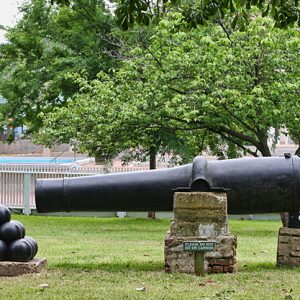calsfoundation@cals.org
Lady Baxter
Lady Baxter is a Civil War–era sixty-four-pounder siege gun that was used by forces loyal to Elisha Baxter in the Brooks-Baxter War, his 1874 altercation with Joseph Brooks over the governorship of Arkansas during Reconstruction. The cannon is on display on the grounds of the Old State House Museum in Little Rock (Pulaski County).
During the Civil War, the siege gun that would become known as Lady Baxter was part of the armaments of the CSS Pontchartrain, one of two Confederate gunboats that plied Arkansas’s waters. Along with most of the Pontchartrain’s other heavy weapons, the gun was removed from the vessel to provide cannon for Fort Hindman, the major earthwork guarding the Confederate garrison at Arkansas Post. A Union expedition conquered Arkansas Post in January 1863, and Confederate engineers later salvaged some of the big guns from there to arm their fortifications protecting Little Rock. When a Union army occupied the capital city in September 1863, Confederate troops spiked and abandoned the cannon before retreating to southwestern Arkansas. The gun then remained on the shores of the Arkansas River until 1874.
Following the contested gubernatorial election of 1874, forces loyal to Joseph Brooks occupied and fortified the State Capitol (now the Old State House Museum). Baxter’s adherents quickly gathered weapons to besiege the building. They located the old gun, cleaned it of rocks and sand, and rebored it so that it would fire. Then, as the Arkansas Daily Gazette reported on May 30, “it was hauled up, and [put on] a carriage manufactured out of railroad rails and the bed-plate of a steam engine. The carriage is a novel one, but very substantial, and answered the purpose admirably.” Baxter put Colonel John Bull in command of his artillery, and the Gazette reported on May 17, 1874, that “the two pieces of artillery commanded by Col. John P. Bull are admired by all who look upon them. They have been named. One of them ‘Lady Baxter,’ the other ‘Lady Wright.’” Lady Baxter was “placed in a position in the rear of the Odd Fellows hall, where it commanded both the river and the state-house. So completely did it command the state-house that a few shots would have demolished the building,” the Gazette reported.
Following the intervention of President Ulysses S. Grant, Brooks abandoned the capitol, and Baxter returned to it on May 19, 1874. Baxter’s supporters staged a victory parade, and a newspaper article nearly seventy years later claimed that a single celebratory shot was fired from the cannon: “It was said at the time, and is still told by those still living, who remember that shot, that windows of buildings for blocks around were shattered by the percussion.” Lady Baxter was placed on display in front of the State Capitol and, though threatened during a World War II scrap drive, remains on display at 300 West Markham Street in Little Rock.
For additional information:
“Bull and Bottaken.” Arkansas Daily Gazette, May 30, 1874, p. 4.
“Items in Brief.” Arkansas Daily Gazette, May 17, 1874, p. 4.
Sherwood, Diana. “Shall ‘Lady Baxter’ Be Junked?” Arkansas Gazette Magazine, October 4, 1942, pp. 9, 15.
Mark K. Christ
Little Rock, Arkansas
 Civil War through Reconstruction, 1861 through 1874
Civil War through Reconstruction, 1861 through 1874 Military
Military "Lady Baxter"
"Lady Baxter"  Old State House
Old State House 



Comments
No comments on this entry yet.